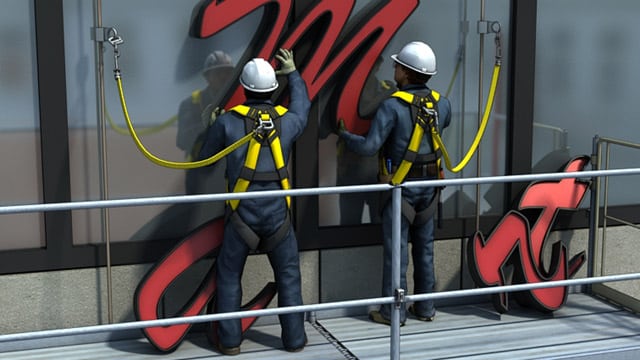




Fall Prevention and Protection – General Industry
Working at elevated heights presents a serious danger of falling. Falls can be caused by inattentiveness, slippery surfaces, working in awkward or out-of-balance positions, or insufficient training. This course highlights numerous methods of fall prevention and fall protection, including fall arrest systems, vertical and horizontal lifelines, and the equipment associated with these systems. It also covers inspection and maintenance guidelines. Key topics include the proper procedure for putting on a body harness, lifeline swing hazards, calculating fall space clearance, and understanding harness suspension syndrome.
Request a demoCourse Details
Learning Objectives
At the end of this course, you will be able to:
- Identify and describe types of fall protection systems, including best practices for their use
- List the steps to put on a body harness in order
- Identify and describe different types of lanyards
- Describe different types of anchorage points
- Define “free-fall distance”
- Identify and describe vertical and horizontal lifelines
- List the calculation factors for determining fall space clearance
- List emergency action plan steps in case of a fall
- List inspecting and maintenance guidelines for fall protection systems
- List fall protection use guidelines in lift equipment
Specs
| Course Level | Intermediate |
| Languages | English, Spanish, Arabic, Portuguese, Chinese, Dutch, French, German, Italian, Japanese, Korean, Tamil, Polish, Russian, Thai, Czech |
| Compatibility | Audio, Video, MobileReady |
| Based on: | OSHA General Industry 29 CFR Part 1910 Subpart D - Walking-Working Surfaces |
Key Questions
Falls are a leading cause of workplace injuries and fatalities, accounting for 300-400 deaths a year. Fall prevention and protection training is crucial to reducing these risks and ensuring workplace safety.
What are some lines of defense against falls and related injuries?The primary lines of defense include being alert, implementing fall prevention measures, and using fall protection systems.
What are considered types of fall prevention?Effective fall prevention strategies include using guardrails, installing rails on stairs, setting up scaffolds, and covering holes in floors.
What is the goal of fall protection?The goal of fall protection is to minimize the impact of falls that do occur by using systems and equipment designed to mitigate fall hazards and injuries.
What equipment is used for fall protection?Key fall protection equipment includes harnesses, lanyards, lifelines, and anchor points. These tools are essential for securing workers and preventing falls.
What is an anchor point?An anchor point is a secure point where fall protection harnesses are attached. There are two types: temporary and permanent.
Is fall protection required when using lift equipment?Yes, fall protection is required for all types of lift equipment, including scissors lifts, lift truck-mounted personnel baskets, crane-suspended personnel baskets, and aerial lifts.
What about crane-suspended baskets?The use of crane-suspended baskets is generally prohibited except in special circumstances and must follow specific guidelines outlined in OSHA’s 29 CFR 1926.550.
What is the last line of defense when dealing with fall hazards?Fall protection is the last line of defense. It should be used in conjunction with other methods such as alertness and fall prevention measures.
When should workers be trained on fall prevention and protection?Workers should receive training when first assigned duties that involve fall risks, when changes in the workplace render previous training outdated, or when there is evidence that the employee lacks necessary knowledge.
Sample Video Transcript
If the worker is not directly under the anchorage point and the worker falls, the worker will likely swing back and forth like a wrecking ball. That swing can send a worker crashing into any object in the swing’s path. The farther the swing, the harder the impact. To reduce this hazard, anchor directly above the work area. If this is not possible, use a higher anchorage point to reduce the swing distance.
Course Applies To
Demos + Pricing
Learn more about our courses, get pricing, and see our platform.











